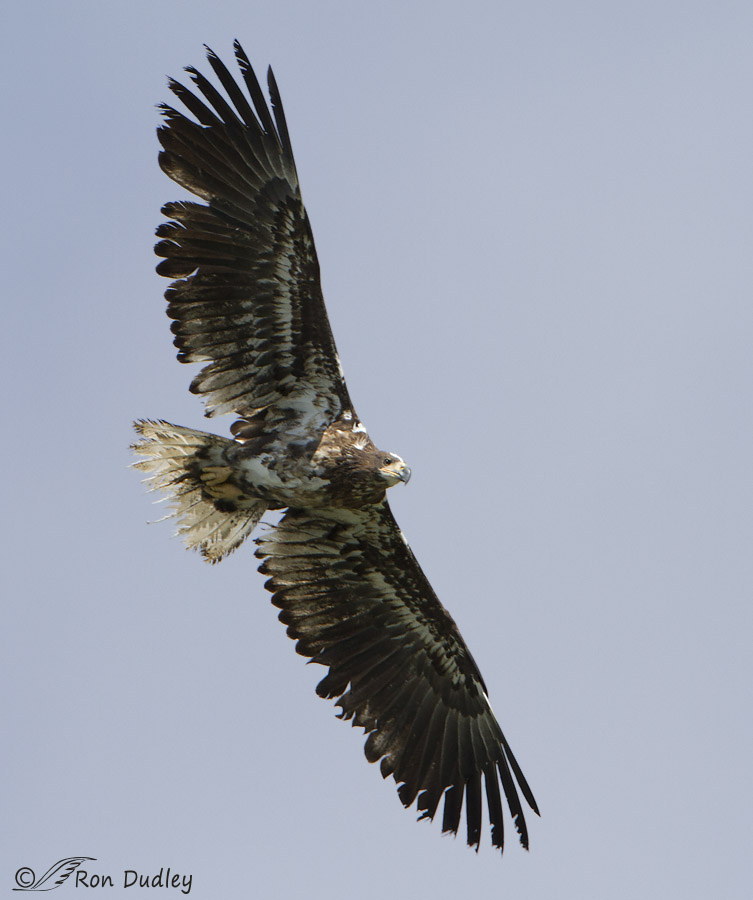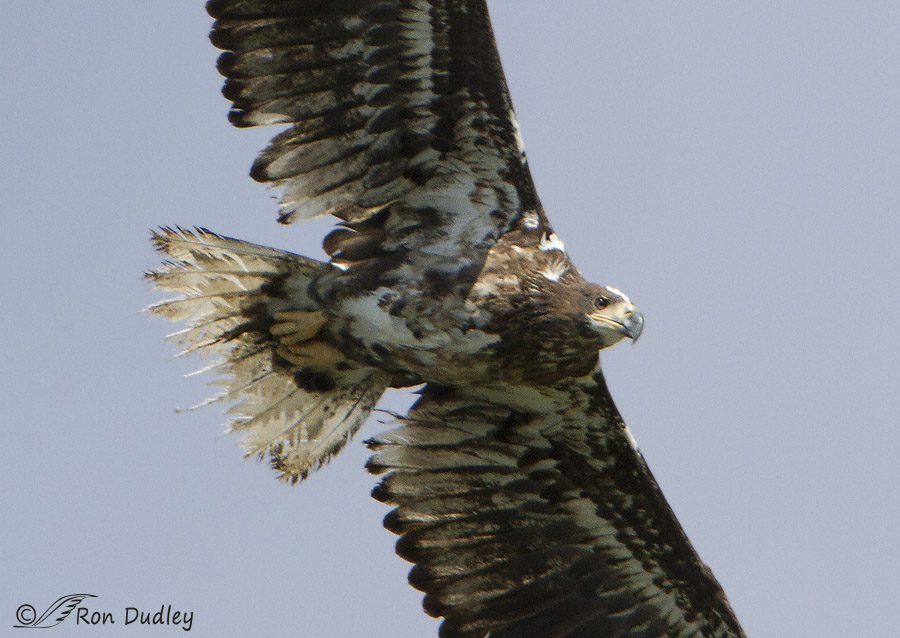By the time early summer rolls around the plumage of many Bald Eagles has taken a beating.
This is due in part to their combative and kleptoparasitic lifestyle. Bald Eagles pirate food from other birds when they can and often capture their own prey only as a last resort. During winter this results in many skirmishes on the ground and ice and causes significant wear and tear on their tail feathers in particular. Throw in their summer molts and they can look pretty scruffy at times.

1/2000, f/7.1, ISO 500, Canon 7D, Canon EF500mm f/4L IS USM +1.4 tc, not baited, set up or called in
I photographed this sub-adult on June 14, 2013 as it soared overhead in Montana’s Centennial Valley. Many of the tail feathers are worn to the point that only the feather shafts (quills) remain for much of their length. The aerodynamic efficiency of that tail must be greatly reduced. Many of the flight feathers are tattered and some are missing.
The annual molt of Bald Eagles begins at the head and neck in the spring but the flight feathers molt later. Tail feathers are molted last in late July and early August and the molt is not complete until late fall.

A large crop of the same image reveals a little more detail about the condition of the tail especially. This bird had to manage with many of these tattered feathers for quite some time yet. I hope it managed well.
I often see up close the stress and abuse these birds put on their tails as they squabble over fish and other food at Farmington during the late winter. They often prop their tails against the ice and/or mud as they fight and maneuver and whenever they’re on the ground their tail is often dragged through the substrate. It’s impressive that those feathers hold up as well as they do.
What tales this tail could tell…
Ron
Another thought: Whenever I see images like this one and look at the position of the feet it makes me wonder – do these birds deliberately hook their curved talons into their undertail coverts to support their relatively heavy feet in flight and keep them out of the airstream? Makes sense to me and it looks like they do but I really have no idea.


Oh Brother, can you spare a feather?
My son said he’s badass. Lol
Assuming he’s referring to the bird that works for me too, Suze. They have to be exactly that in order to survive what they go through.
Amazing shots Ron!
Charlotte
Thanks, Charlotte.
Every time I read–or am reminded of–statistics re birds’ survival rates, I am more and more amazed and thankful to have seen the ones I’ve seen. Would never dream that even the color of flight feathers has an impact on their survivability. Hoping this BAEA found its permanent territory in the Centennial Valley and so at least didn’t have to worry about the air friction of long-distance travel! Great (though sad-looking) photos and information. Thanks to you & Dan for both.
“Every time I read–or am reminded of–statistics re birds’ survival rates, I am more and more amazed and thankful to have seen the ones I’ve seen”
Very well said, Chris. Yes, thankful!
Fascinating, scary, heart-breaking. Thank you to you, and your commentators, particularly Dan. A day where I learn things is off to a wonderful start…
I hope the learning continues all day for you, EC.
Gosh, Ron-they almost look to be singed…do you think it at all possible this is damage from a methane flare?
I don’t think so, Leslie. I’ve seen other eagles with wear that looks like this, though this one is surely worse than most.
Most interesting. I’ve seen a few Bald Eagles in my time, but never one that looked like this. I find myself wondering how a bird like that can survive when the molt takes that long and the tail feathers are in such bad shape. Hope this one did make it.
Susan, I think Dan Gleason describes the survival chances of this bird well (toward the end of his comment below).
A rough condition, indeed. It’s tough being a raptor, especially in your first year or two when you need to learn all of your survival skills. These photos emphasize why a dark tail is important to young eagles. The melanin (the dark pigment) makes a feather stronger. A dark feather is less susceptible to breakage and to wear from keratin-eating bacteria, from mechanical abrasion and friction against the air itself. The white feathers of an adult would long since have been destroyed by whatever abuse this bird has seen, but dark feathers increase the survival chances. Note that the flight feathers of all long distance migrants are dark. Snow Geese, for example, as well as Western Tanagers, Black-headed Grosbeaks, American White Pelicans, etc., etc. Those with white flight feathers, like egrets, typically make only short hops and have less need of the strong, dark feathers. It may be hard to imagine, but frictional forces against the air cause significant feather wear. Those albino hummingbirds that you sometimes see images of online, are doomed to a very short life. Being so dependnt on flight, the feathers wear quickly and these birds become unable to fly before they can reach their first molt.
The varied life style of a Bald Eagle (hunter, fisher, pirate, carrion-eater) gives it a better chance of survival than many raptors. For most species, up to 70% or more of birds do not survive their ffirst year. For Bald Eagles, the survival rate can be as high as 50%. This bird is having a hard time, and with a good and easy food supply, it might make it until molt, but its going to be a struggle.
Thanks for sharing such grest photos, as usual.
Dan Gleason
What great information, Dan! Your contribution to this post is invaluable and much appreciated, by me and I’m sure by my readers. I’d have responded earlier but I’ve been out shooting all morning.
I’d read about the advantages of dark feathers some time ago but I’m embarrassed to admit that bringing it up here didn’t even cross my mind. It should have.
That said, I didn’t know about the feather wear caused by frictional forces of air. But it makes perfect sense.
Thanks again.
Battered is right. Did you ever come across this bird again?
No, Bill. I never saw the bird again after this day. But I wasn’t up there for long after that either.
Hi!
Yes it does look battered! Could it have been a mix of a Golden Eagle ? Do they ever cross bred? Love the Photo! Keep up you great work! Have a special day shooting!
No, this is an immature Bald Eagle, Hummingbird Lover. They don’t reach their full adult plumage until they’re almost 6 years old. Until then they can resemble Golden Eagles in some ways.
This image reminds me of those aircrafts from World War II returning from a mission under heavy fire. It is amazing how it still can fly.
I am sure it would be a very interesting story those feathers could tell.
Thank you for the annual molt explanation. I didn’t know that.
Excellent analogy, Jorge.
Great photo, Ron. What a graphic representation of the wear and tear on such an active bird of prey and opportunistic raider! I feel a great deal of respect for the price they pay to stay alive and thrive as best they can. Thanks!
Agreed, Alison. Bald Eagles have a tough row to hoe during winter especially. They’re truly survivalists. Thank you.